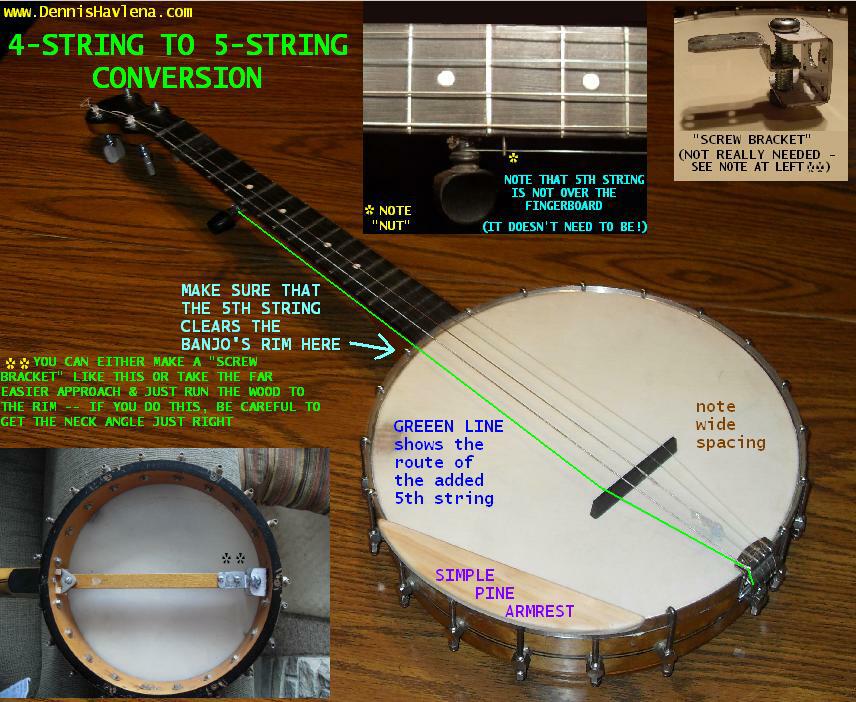
Here's what I did: - A few frets were missing on the low end, so I borrowed from Peter to pay Paul -- robbed them from the high end, where I never play anyways, then cut them to fit & glued them in with Elmer's glue (I wanted a somewhat weak glue in case fret removal was ever called for). - I similarily massaged Elmer's glue into both sides of all frets, some of them being a bit wiggly. - These type of old banjos usually have this godawful type of neck/body attachment affair. It's pretty "intuitive" (normally hate that word!) to see what to do to get the neck angle right. Although I didn't have to (I could have just experimented with where the end of the square "dowel" that runs inside the banjo's body attaches to the wooden rim, just below the tailpiece, to set the proper neck angle) I instead made a simple "screw-bracket" adjustable affair that made neck-angle adjustment very simple and easy. See photo. I stress that making such a "screw-bracket" is not necessary. - Perhaps the most unconventional aspect of this conversion is how I configured and ran the 5th string. Being that the 5th string is never fretted, there's no reason that it need be located over the fingerboard! Not only does running the 5th string over "thin air" allow you to use the 4-stringer's original main-string spacing, but it also negates the need to "build-up" a "fingerboard" underneath the 5th string (as is seen with the "wings" in other conversions described on the internet). SO, my 5th string runs from the installed ebony, fiddle-type tuning peg then over a simple "nut" (3/4" length of broken 1/16" drill-bit shank in my case, that I set in a hole drilled into the neck -- see photo). The 5th string therefore sets quite low at the left end but sets at about the same heigth as the playing strings near the bridge. A consideration here is that the 5th string must obviously "clear" the banjo's rim -- but it does so with room to spare on my instrument. Because the 5th string's heigth near the bridge is about the same as the playing strings, no "weirdness" of any sort is noticed while playing. Because I prefer nylon strings, I used a simple inexpensive ebony fiddle peg to tune the 5th string. Drilling and tapering the hole for this (near the 5th fret) need not be a challenge. I have no tapered reamer, so what I did was make a series of "stepped drillholes" to approzimate the proper taper & then, using small pieces of sandpaper wound around the still full-length peg (cut peg to proper length later), I rotate this round and round until the drilled "steps" are smoothed out. I find that it is not necessary to get this taper perfect -- even if close, the peg holds & turns nicely. Nothing complicated here. Of course, an $8 commercial 5th string tuner can be installed here instead of the ebony fiddle peg. - Made a simple wooden arm-rest that greatly added to the comfort of playing. This arm-rest was silicone glued in place. _ I very much dislike close string spacing on any instrument. While a stock banjo bridge WILL work fine with this conversion, I instead made mine in a few minutes out of hardwood. Nothing fancy. They do not have to even look like what a banjo bridge "should" look like. - After a good deal of experimenting, I have settled upon the string configuration below as ideal for my purposes. 4-stringers have a shorter neck than 5-stringers -- in my case 4 frets shorter. This is in no way undesirable, but does necessitate thinking about string gauge. I started out measuring the string diameter of the nylon strings on my regular (Gretsch) banjo, then added about three thousandths of an inch to these diameters & looked for appropriate diameters in my box of nylon fishing line & other odd strings. Here's what worked fine: For the 4 playing strings (high to lo), .027" (50 pound) fishline, .028" (60 pound) fishline, .030" wound nylon guitar string (the "D" string from an inexpensive Savarez classical guitar set), .034" wound nylon guitar string (the "A" string from the same Savarez set). For the 5th string, I used .022" (40 pound) fishline -- perhaps a bit thinner than I should have used, but I wanted to be able to tune this string up a couple of frets when playing in a different tuning & not have to use any kind of 5th-string capo. This worked out as planned nicely. As a matter of long observation, I have yet to see an old banjo with a properly adjusted nut. Take pains to see that the nut is grooved deeply enough so it doesn't add to finger grief. Obviously, don't make the grooves too deep. Just proceed slowly & check very often. All adjusting and the like is very simple - just use some common sense. Experience here is not that important. All these words make it sound far more complicated than it really is to make this comversion. Just do it. Obviously, please do not make this conversion on any valuable, vintage instrument! There are any number of old junkers lying about in second hand shops etc. This thing looks nice, plays nice, sounds nice and is rapidly becoming my favorite banjo. Dennis Havlena - W8MI www.DennisHavlena.com northern Michigan